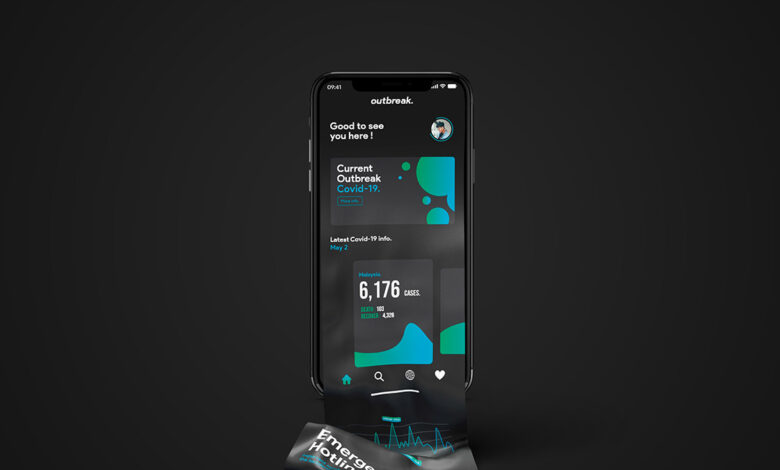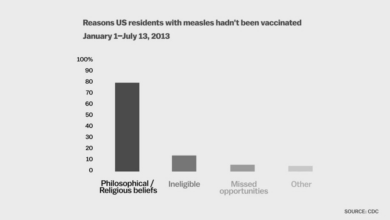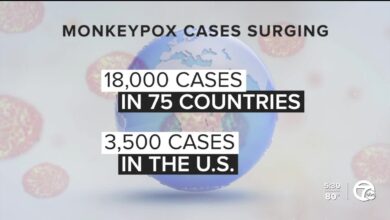
New apps can pinpoint illness outbreaks, offering a revolutionary approach to disease tracking. These applications leverage data collection and analysis to identify potential outbreaks swiftly, enabling proactive public health interventions. From analyzing symptom patterns to using social media data, these innovative tools hold immense promise for early detection and containment. We’ll explore the various types of apps, the methods behind their effectiveness, and the potential benefits, challenges, and ethical considerations surrounding their use.
The history of disease outbreak tracking has evolved dramatically, from traditional methods relying on manual data collection to the real-time analysis capabilities of modern mobile applications. These apps have the potential to significantly improve public health preparedness and response by providing a more comprehensive and immediate view of potential outbreaks. Let’s delve into the details and explore the potential of these innovative technologies.
Introduction to Disease Outbreak Pinpointing Apps

Disease outbreak pinpointing applications are rapidly becoming crucial tools in the fight against infectious diseases. These apps leverage technology to detect, track, and respond to outbreaks more efficiently than traditional methods. By collecting and analyzing data from various sources, these applications can provide valuable insights into the spread of illnesses, enabling public health officials to implement targeted interventions and contain outbreaks more effectively.
This proactive approach aims to minimize the impact of diseases on individuals and communities.The general principles behind these applications revolve around the collection of data, encompassing symptoms, location, and time of exposure. Sophisticated algorithms process this data, identifying patterns and anomalies that could signal the emergence of an outbreak. This analysis allows for the rapid identification of potential hotspots and the prediction of future infection clusters.
Different Types of Outbreak Pinpointing Apps
These applications cater to diverse needs and settings. Public health agencies use them to monitor disease trends, analyze epidemiological patterns, and coordinate responses. Hospitals leverage these tools to track infection rates within their facilities, enabling timely isolation protocols and preventing further spread. Individuals can also use these apps to self-report symptoms, potentially alerting authorities to emerging trends in their local communities.
Methods for Detecting Outbreaks
These applications employ various methods to detect outbreaks. Data sources range from user-reported symptoms to hospital discharge summaries to lab-confirmed diagnoses. Algorithms are designed to analyze this data, looking for unusual clusters of cases in specific geographic areas or time periods. Sophisticated machine learning models can even predict potential outbreaks based on historical data and current trends.
Robust communication strategies are also vital, ensuring timely alerts to relevant parties and facilitating swift responses.
Historical Evolution of Outbreak Tracking
The history of disease outbreak tracking is marked by a progression from traditional methods to cutting-edge mobile app solutions. Early approaches relied heavily on manual data collection and analysis, often leading to delays in identifying and responding to outbreaks. The advent of mobile technology has revolutionized this process by allowing for real-time data collection and analysis, empowering faster identification of outbreaks and improved response times.
This evolution is driven by the need for faster and more efficient disease surveillance systems.
Data Collection and Analysis Methods
Disease outbreak pinpointing apps leverage diverse data sources and sophisticated analytical techniques to identify and track outbreaks. These apps are crucial tools for public health agencies and individuals alike, providing timely information that enables swift response and mitigation strategies. The success of these apps hinges on effective data collection and analysis methodologies.
Data Collection Methods, New apps can pinpoint illness outbreaks
These apps employ a variety of methods to gather information about potential outbreaks. Understanding these diverse approaches is essential to assessing the strengths and limitations of each. Collecting data on symptoms, locations, and social media chatter allows for rapid identification of emerging patterns. The collection of epidemiological data is crucial for determining the origin and spread of a disease.
- Symptom-based reporting: Users report their symptoms through the app, providing a real-time snapshot of illness trends in a particular geographic area. This is particularly valuable for tracking the spread of contagious diseases. Data is usually anonymized to protect user privacy.
- Location-based data: The app can utilize GPS to record the location of reported cases. This allows for the identification of clusters of illness in specific areas, which could indicate an outbreak.
- Social media monitoring: Some apps employ algorithms to scan social media platforms for mentions of symptoms, illnesses, or potential outbreaks. This provides a broader view of the public perception of health issues. However, it’s important to note that social media data can be unreliable, requiring careful scrutiny and contextualization.
- Public health databases: Data from official public health databases and reports can be integrated into these apps. This adds a layer of reliability by leveraging existing data sources, potentially improving accuracy and completeness. The inclusion of data from multiple sources improves the breadth of the information.
Data Types
The apps utilize various data types, including but not limited to:
- Symptoms: Users report specific symptoms, like fever, cough, or diarrhea. This data aids in identifying patterns and similarities among cases.
- Location: GPS data helps pinpoint the geographical origin and spread of illness. This is especially critical in identifying local clusters of cases.
- Social media posts: Information gathered from social media, like online discussions about illnesses, can provide insights into public awareness and potential outbreaks. This often complements other data sources. However, the accuracy and reliability of social media information needs careful consideration.
- Demographics: Information about age, gender, and other demographics can be helpful in understanding potential risk factors or the impact of the outbreak on different segments of the population. This data can highlight disparities in susceptibility or impact.
Data Analysis Methods
The collected data is analyzed using various methods, with machine learning and predictive modeling playing crucial roles.
New apps are revolutionizing how we track illness outbreaks, making it easier to pinpoint the source and contain the spread. However, while these technological advancements are promising, it’s important to remember that effective preventative measures, like wearing cloth masks, are still crucial. For instance, plastic face shields aren’t a viable replacement for cloth masks, as detailed in this informative piece about why plastic face shields aren’t a safe alternative to cloth masks why plastic face shields arent a safe alternative to cloth masks.
These apps, combined with responsible safety measures, offer a powerful toolkit for combating future outbreaks.
- Machine Learning: Algorithms can identify patterns and anomalies in the data, potentially predicting future outbreaks. This includes identifying clusters of similar cases, locations, or symptoms. Machine learning algorithms can be trained to recognize and classify various types of data, enabling more accurate prediction.
- Predictive Modeling: Models can forecast the potential spread of an outbreak based on various factors like population density, mobility patterns, and the characteristics of the disease. For example, a model might predict the likelihood of an outbreak spreading to a particular region. These models provide a valuable tool for public health agencies in resource allocation and proactive intervention.
- Data Visualization: Outbreak trends are presented using various visualization techniques, such as maps, charts, and graphs. These visualizations allow for easy identification of patterns and clusters, aiding in understanding the scope and spread of the outbreak. This can highlight areas with high concentrations of cases, allowing for targeted interventions.
Example of Data Visualization
A map could display the geographic distribution of reported cases, highlighting clusters and potential areas of concern. A time series graph could illustrate the daily increase or decrease in reported cases, allowing for the identification of trends and potential spikes. Such visualizations are instrumental in understanding and communicating the nature of the outbreak to the public and healthcare professionals.
Data Collection Methods Comparison
| Method | Data Source | Advantages | Disadvantages |
|---|---|---|---|
| Symptom-based reporting | App users | Real-time data, user-driven | Potential for inaccurate reporting, limited data depth |
| Location-based data | GPS | Precise location tracking, identification of clusters | Privacy concerns, potential for misreporting |
| Social media monitoring | Social media platforms | Broader public perception, early warning system | Inaccurate information, unreliable data |
| Public health databases | Official reports | High reliability, comprehensive data | Delayed data, limited accessibility |
Potential Benefits and Applications
Disease outbreak pinpointing apps offer a powerful tool for public health interventions, potentially revolutionizing how we respond to emerging health crises. By leveraging real-time data and sophisticated algorithms, these applications can provide crucial insights into the spread of infectious diseases, enabling quicker and more targeted responses. This early detection capability can significantly reduce the impact of outbreaks and save lives.These applications, beyond their immediate use in public health crises, can also contribute to broader public health initiatives.
Their capacity to collect and analyze data can lead to a better understanding of disease patterns and risk factors, ultimately improving disease prevention strategies and overall community health. This understanding can also aid in developing more effective public health policies and interventions.
Potential Benefits of Early Outbreak Detection
Early detection of disease outbreaks is paramount to controlling their spread. Real-time data collection and analysis provided by these apps allow for swift identification of emerging trends, which enables the immediate implementation of containment measures. This rapid response can significantly limit the geographic spread of the disease, reducing the overall impact on the population. The early identification of unusual patterns in reported cases can help public health officials proactively prepare for a potential surge in infections, allowing them to optimize resource allocation and enhance preparedness.
Applications in Different Contexts
These apps can be applied in diverse settings. In a real-world scenario, a surge in respiratory illness cases in a particular region could trigger the app to flag an unusual pattern, alerting local health authorities to a possible outbreak. This prompt notification allows them to investigate the cause and implement appropriate interventions quickly. Hypothetically, an app could identify clusters of cases associated with specific food products, leading to the swift recall of contaminated goods and preventing further illness.
Examples of Successful Applications in Other Fields
Similar technologies have proven effective in other fields. The rapid spread of information about social media trends and news events demonstrates how user-generated data can be leveraged for real-time monitoring and analysis. Furthermore, predictive models in fields like weather forecasting use historical data and algorithms to forecast future events, mirroring the potential of these apps to predict disease outbreaks based on epidemiological patterns.
Potential Limitations of Using Apps for Outbreak Detection
While promising, these apps face limitations. Data accuracy and completeness rely heavily on user reporting, which can be influenced by factors such as awareness levels and the willingness of individuals to provide information. Ensuring data quality and minimizing bias are critical for the reliability of the app’s insights. Furthermore, the need for continuous updates and maintenance to ensure the app’s accuracy and relevance is crucial.
Comparison of Potential Benefits and Drawbacks
| Benefit | Drawback | Setting |
|---|---|---|
| Rapid identification of emerging trends | Data quality dependent on user reporting | Community Health Centers |
| Targeted intervention measures | Potential for false alarms and overreaction | International Travel Hubs |
| Enhanced public health preparedness | Privacy concerns related to data collection | Schools and Universities |
| Improved disease surveillance | Maintenance and updates necessary for accuracy | Rural Communities |
Ethical Considerations and Challenges
Disease outbreak pinpointing apps, while offering promising solutions, raise significant ethical concerns. The very nature of these applications, relying on personal health data, necessitates a careful consideration of privacy, security, and potential biases. Responsible development and deployment must prioritize user rights and data protection, ensuring that these powerful tools are used ethically and effectively.
Ethical Implications of Using Personal Health Data
The use of personal health data for outbreak detection raises significant ethical considerations. Individuals’ health information is inherently sensitive and private. Its use for public health purposes must be approached with caution and transparency. Balancing the need for swift outbreak response with the right to privacy is a crucial aspect of this process. Trust and informed consent are essential components in gaining user acceptance and ensuring responsible data handling.
Challenges in Ensuring Data Privacy and Security
Ensuring data privacy and security is a critical challenge in the development and implementation of these apps. Protecting user data from unauthorized access, breaches, and misuse is paramount. Robust encryption methods, secure data storage, and regular security audits are essential safeguards. The potential for data breaches, particularly with the increasing reliance on digital health records, requires proactive measures to mitigate risks.
Furthermore, ensuring compliance with relevant data protection regulations, such as GDPR or HIPAA, is a legal and ethical imperative.
New apps are revolutionizing how we track illness outbreaks, offering real-time data that’s crucial for public health initiatives. This is particularly important in places like Howaa City, where community health is a top priority, as detailed in their impressive program on howaa city gets healthy howaa city gets healthy. By pinpointing the source and spread of illnesses, these apps can help prevent widespread infections and empower communities to stay healthy.
Importance of User Consent and Data Protection
User consent and data protection are fundamental to the ethical use of personal health data. Clear, concise, and easily understandable consent mechanisms must be implemented. Users should be informed about how their data will be collected, used, and protected. Transparency about data usage and potential risks is crucial. This includes specifying how the data will be anonymized and de-identified to maintain privacy.
Comparison of Data Anonymization and De-identification Approaches
Various methods exist for anonymizing and de-identifying personal health data. Pseudonymization, where identifying information is replaced with unique identifiers, offers a balance between privacy and data utility. Data aggregation, where individual data points are combined to create statistical summaries, can also protect privacy while allowing for useful insights. Differential privacy, which adds noise to the data, further obscures individual data points.
The choice of approach depends on the specific use case and the sensitivity of the data involved. Each method has its limitations, and careful consideration must be given to the potential for re-identification and the level of privacy protection offered.
Potential Biases in Data and Algorithms
Data used to train algorithms for outbreak detection can contain inherent biases. These biases can lead to inaccurate or unfair results. For example, if the data primarily reflects the health characteristics of a particular demographic group, the algorithm might be less accurate for other groups. Algorithms themselves can also perpetuate biases present in the training data. Careful attention must be paid to the representativeness of the data and the potential for algorithmic bias to ensure fairness and equity in the application’s results.
Real-World Ethical Dilemmas Faced by Similar Applications
Past instances of health data breaches or misuse highlight the challenges of managing ethical considerations. For example, issues related to the use of patient data for research without proper consent have been documented. The potential for discrimination based on health status or other characteristics is another concern. Careful scrutiny of existing systems and policies is essential to avoid repeating past mistakes.
Guidelines for Responsible Development and Use of Outbreak Pinpointing Apps
A set of guidelines for responsible development and use of these apps should be established. These guidelines should prioritize user consent, data security, and algorithmic fairness. They should also ensure compliance with relevant data protection regulations. Transparency regarding data handling, algorithmic design, and potential limitations should be paramount. Furthermore, independent audits and evaluations of the app’s performance and impact on privacy are essential.
Finally, mechanisms for user feedback and redress should be in place to address any concerns.
Technological Advancements and Future Trends
The landscape of disease outbreak detection is rapidly evolving, driven by innovative technologies. Apps are becoming more sophisticated, leveraging data analysis techniques and real-time information to provide timely and accurate alerts. This shift allows for quicker response times, potentially saving lives and mitigating the spread of illness. Furthermore, emerging technologies are poised to revolutionize outbreak detection, potentially transforming the way we approach public health crises.
Latest Technological Advancements in App Development
Recent advancements in app development are crucial for enhancing outbreak detection. Sophisticated algorithms are being integrated into apps to analyze vast datasets, identifying patterns and anomalies that might indicate the early stages of an outbreak. These apps can now process data from various sources, including social media, news reports, and even online searches, providing a holistic view of potential outbreaks.
Machine learning models are also playing a key role in identifying potential trends, predicting disease spread, and pinpointing the epicenter of outbreaks.
Potential Future Trends: AI and Machine Learning
Artificial intelligence (AI) and machine learning (ML) are poised to revolutionize outbreak detection. AI algorithms can analyze large datasets from diverse sources (medical records, social media, etc.) to identify subtle patterns indicative of emerging outbreaks. These patterns might not be immediately obvious to human analysts, but AI can detect them quickly and accurately. ML algorithms can also predict disease spread, identifying high-risk areas and facilitating proactive interventions.
For example, during the COVID-19 pandemic, AI-powered systems helped predict infection hotspots, allowing for targeted resource allocation.
Wearable Sensors and IoT Devices for Data Collection
Wearable sensors and Internet of Things (IoT) devices are emerging as powerful tools for data collection. These devices can monitor individuals’ health parameters in real-time, providing valuable data points that can be used to detect early signs of illness. This data, when combined with location information and other relevant data, can be invaluable in pinpointing the origin and spread of an outbreak.
For instance, smartwatches equipped with temperature sensors could potentially identify individuals with fevers, allowing for prompt isolation and preventing further transmission.
New apps are amazing at pinpointing illness outbreaks, quickly identifying hotspots and patterns. This is super helpful, but successful vaccine rollouts, like those in North Dakota and West Virginia, which have found innovative ways to streamline the process , demonstrate the crucial importance of community engagement and clear communication. Ultimately, both approaches are vital in managing health crises.
Innovative Applications of Emerging Technologies
The integration of these technologies is leading to innovative applications. One example is the development of apps that can analyze social media data to identify symptoms and behaviors associated with emerging infectious diseases. By tracking s, hashtags, and location data, these apps can detect unusual patterns and provide alerts to public health officials. Another example is the use of AI-powered diagnostic tools that can analyze medical images, such as X-rays or CT scans, to detect potential outbreaks.
Such tools can significantly reduce diagnostic delays and facilitate quicker interventions.
Table of Future Trends in Outbreak Detection
| Trend | Description | Impact |
|---|---|---|
| AI-powered predictive modeling | Using AI algorithms to predict the spread of diseases and identify high-risk areas. | Improved proactive response, allowing for targeted resource allocation and early intervention. |
| Real-time data analysis from wearable sensors | Using data from wearable sensors to monitor health parameters and identify early signs of illness. | Enhanced early detection, enabling quicker isolation and preventing further transmission. |
| Integration of social media data | Using social media data to identify patterns associated with emerging outbreaks. | Faster identification of outbreaks and improved understanding of disease spread. |
Public Health Implications and Impact
Disease outbreak pinpointing apps are poised to revolutionize public health preparedness and response, offering unprecedented opportunities to combat the spread of infectious diseases. Their ability to rapidly identify and track outbreaks can lead to faster containment strategies, ultimately saving lives and mitigating the devastating economic consequences of epidemics. These applications offer a significant step forward in the ongoing battle against infectious diseases, enabling more proactive and effective public health interventions.These applications have the potential to significantly improve the efficiency of disease control measures by enabling real-time data collection and analysis.
By allowing for rapid identification of potential outbreaks, these apps can facilitate prompt interventions, limiting the spread of infectious agents. This translates into a faster and more targeted public health response, with a demonstrably lower impact on affected populations.
Impact on Public Health Preparedness and Response
These apps provide a crucial tool for early warning systems, enabling public health officials to detect potential outbreaks early. This allows for a rapid deployment of resources and interventions, potentially stemming the spread of disease. Real-time data from these applications can also inform public health strategies, leading to better allocation of resources and more effective containment measures.
Improving Efficiency of Disease Control Measures
The speed and efficiency of data analysis in these applications are unparalleled compared to traditional methods. By allowing for the identification of geographical clusters and epidemiological patterns in near real-time, these apps significantly expedite the investigation and response phases. This leads to a reduction in the time taken to implement control measures, often a critical factor in containing outbreaks.
Role in Facilitating Public Health Interventions
These applications facilitate public health interventions by providing crucial information to inform targeted interventions. The data collected can be used to understand disease transmission patterns, enabling the development of tailored public health messages and interventions. This personalized approach is crucial for effective public health campaigns and ensures that resources are allocated to the most vulnerable populations. Furthermore, the apps can facilitate the dissemination of crucial health information to the public, empowering individuals to take preventive measures.
Real-World Examples of App Usage
While specific examples of publicly available and widely deployed apps for outbreak detection are still relatively limited, the concept has been tested in various pilot programs. For example, apps are being used to monitor symptoms and track movements of individuals with suspected infections, which allows for the rapid identification and isolation of potential cases. Such initiatives, although still in their nascent stages, demonstrate the potential of these apps to improve public health interventions.
Benefits and Drawbacks of Using Apps for Disease Surveillance
The benefits of using these apps for disease surveillance are substantial, offering real-time data, rapid analysis, and enhanced coordination. This enables proactive responses and minimizes the impact of outbreaks. However, drawbacks exist, including potential data privacy concerns, the need for robust data validation and verification mechanisms, and the potential for misinterpretations of the data. Furthermore, the reliance on user compliance with reporting requirements and app usage needs careful consideration.
Comparison of Effectiveness
| Method | Effectiveness | Limitations |
|---|---|---|
| Traditional Surveillance Methods | Effective in detecting outbreaks but often delayed due to manual data collection and analysis. | Slower response times, reliance on pre-existing infrastructure, limited real-time data access. |
| App-Based Interventions | Potentially faster detection and response, offering real-time data analysis and targeted interventions. | Data accuracy depends on user participation, potential for bias in data collection, and concerns regarding data privacy and security. |
These apps present a powerful tool for public health, yet careful consideration of the potential limitations is paramount. The table above illustrates a comparative analysis of the strengths and weaknesses of traditional methods and app-based approaches.
Wrap-Up: New Apps Can Pinpoint Illness Outbreaks

In conclusion, new apps can pinpoint illness outbreaks represent a significant advancement in public health. While challenges like data privacy and ethical considerations remain, the potential benefits for early detection and containment are substantial. These apps hold the key to a more proactive and efficient approach to disease surveillance, ultimately leading to better health outcomes for communities worldwide.
Further development and careful implementation will be crucial to realizing their full potential.




